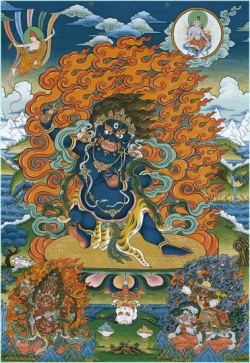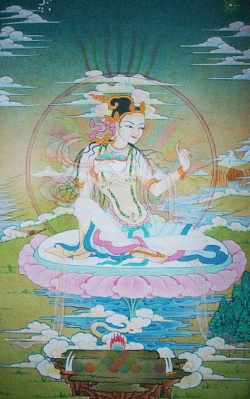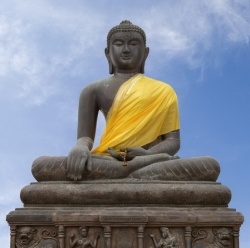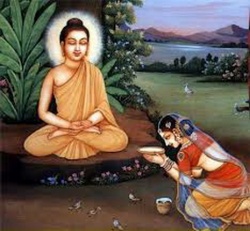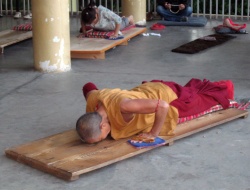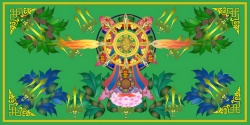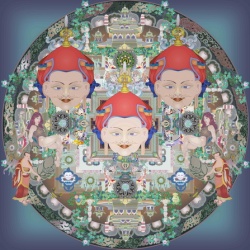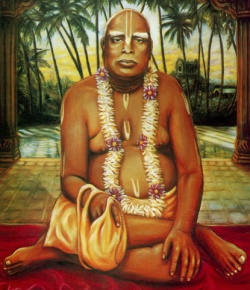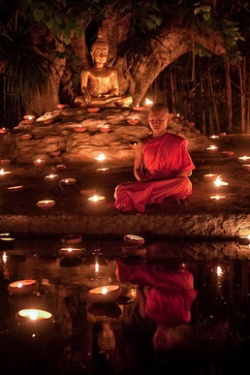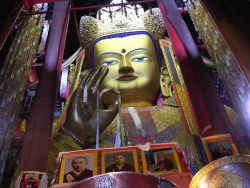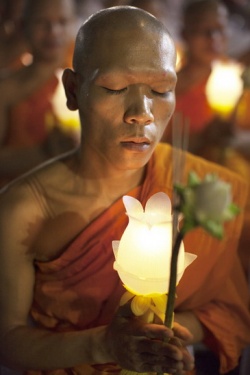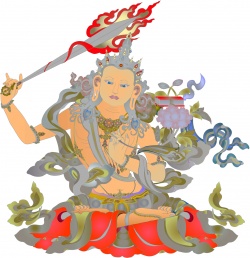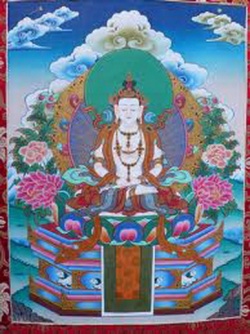The Life of Zanabazar 2
Altan Khan and the Dalai Lama
The meetings of Altan Khan and his nephew with Tibetan and perhaps Uighur monks were not the first time Mongolians had encountered the teachings of Buddha. According to the Rosary of White Lotuses, Chingis Khan himself met with some Tibetan Buddhists as early as 1205, a year before the founding of the Mongol Empire, and had been impressed by their doctrines. He sent a message to the Sakya lama So-pan stating, "I have not finished the wars of my reign yet, but as soon as these are over, please come to Hor with your disciples and spread the Teachings of the Lord Buddha." Not everyone accepts this account, however, since So-pan, better known as the Sakya Pandita, would have been only twenty-three years old in 1205. In any case, the Rosary of White Lotuses goes on to claim that Chingis and Sakya Pandita eventually established between themselves the Preceptor-Protector relationship which would become a standard feature of later interactions between Tibetan religious leaders and secular rulers both Mongolian and Chinese. There is little evidence, however, that Chingis himself ever embraced Buddhist teachings. Although dabbling in various spiritual traditions, including Taoism, he apparently remained true to the shamanic beliefs of his ancestors to the end of his life.
More substantive contacts between Mongolians from north of the Gobi and Buddhism occurred in 1219 when the Mongol general Mukali overran the city of Lan Ch'eng in Shansi province and captured a monk by the name of Hai-yün, a follower of the Ch'an sect which was popular in China and not a Tibetan Buddhist. Impressed by the spiritual presence of Hai-yün, Mukali asked to met the monk's teacher, Chung-kuan. Mukali wrote a favorable report about the two men to Chingis Khan himself. The Great Khan replied:
'From what your messengers have told me, it appears that the Old Reverend One and the Young Reverend One are both true "Speakers to Heaven." Feed and clothe them well, and if you find any others of the same sort, gather them all in and let them "speak to Heaven" as much as they will. They are not be treated with disrespect by anyone . . .'
Güyük Khan, grandson of Chingis who became Great Khan after the death of his father Ögedai, named Hai-yün chief of all monks in the Mongol realm, which by then included a large swath of China, and invited him to live in Kharkhorum. He held the same post under Möngke, Güyük's successor. Hai-yün may have converted Khubilai, Möngke's successor, to Buddhism as early as 1242, and he himself chose the name for Khubilai's oldest son, Chen-chin (Pure Gold). Hai-yün died in 1257, but his disciple Liu Ping-chung became an advisor of Khubilai when the latter became Great Khan, and he was instrumental in the creation of the new Mongol capital of the Yüan Dynasty at what is now Beijing.
The Ch'an School of Buddhists were soon interceded by Tibetans. In 1239 Ogedei's son Koden, having occupied Sichuan province in China, decided to invade neighboring Tibet. Quickly deciding to sue for peace, the Tibetans sent So-pan, the abbot of Sakya Monastery, the headquarters of the Sakya sect of Tibetan Buddhism, to negotiate with the Mongols. So-pan- Sakya Pandita-was a renowned scholar who written numerous learned treatises, including the Treasury of Good Advice (still in print today. ).
By 1247 an arrangement had been worked out whereby Sakya Pandita pledged the allegiance of Tibet to the Mongols while he himself retained political authority over all of Tibet. Justifying his actions, he wrote to the heads of other monasteries:
This king (Koden) is a bodhisattva, who has the greatest faith in the Buddhist teachings generally, and the three gems in particular. He protects the universe by good laws, and particularly he has a great attachment to me far above the others. He said to me, 'Preach religion with a tranquil mind, I will give you what you wish. I know that you do good, heavens know if I do also.
While Koden and the Mongols may have first favored the Buddhist hierarchy in Tibet as a political expediency they were soon attracted to Tibetan Buddhist teachings and doctrine. As the historian of Buddhism in China Kenneth Ch'en points out,
The Mongols, on their side, were converted, partly through fear of the mysterious powers emanating from the formulas and charms of Lamaism [a term for Tibetan Buddhism no longer favored in scholarly circles] and partly because of the belief that Lamaism was better adapted to their temperament and habit, since both they and the Tibetans were hardy, accustomed to life in the open, and averse to agriculture.
Other observers have pointed out the that Tibetan Buddhism was still at that time greatly influenced by the ancient shamanism and animism of Tibet, and thus may have been more compatible with the belief systems of the Mongols, many of whom remained faithful to the shamanism and nature worship of their own ancestors.
In 1253 Khubilai invited Sakya Pandita to his court but the Tibetan lama died before the invitation arrived. His nephew Sakya Pakpa (also known as Phags-pa, (b.1238?-1280) accepted the offer in Sakya Pandita 's stead and soon made his way to the Khan's presence. Khubilai was greatly impressed by the young Tibetan, then only in this twenties. When Khubilai assumed the title of Great Khan in 1260 he made Sakya Pakpa his ti-shih, or "imperial preceptor" and declared that henceforth the Tibetan form of Buddhism would be the official religion of the Mongols. Thus at this time the Tibetan variant superceded the Ch'an Buddhism which had been favored by Güyük and Möngke, Khubilai's predecessors as Great Khan.
As Imperial Preceptor Sakya Pakpa had considerable authority and prestige, sitting always at the Great Khan's side at court and received with great honors and ceremony wherever he traveled. In 1264 the office of Imperial Preceptor was enlarged to include all affairs connected with Tibet and Buddhism, secular and religious, giving Sakya Pakpa even more power. Sakya Pakpa was also a remarkable scholar who developed an elaborate Buddhist religio-political theory of world rule. In addition he spent five years developing a script for the Mongolian language based on the Tibetan script. This became the official writing system of the Mongol Empire in 1269, mandatory in all government documents, but although scholars still opine that it was the best script for the linguistic idiosyncrasies of the Mongolian language the Mongols later reverted back to the Uighur form of writing which had been adopted at the time of Chingis Khan. Sakya Pakpa remained in Mongolia until 1274, when he returned to Tibet, where he died in 1280, at the age of about forty-two, apparently worn out by his extensive labors on behalf of his Mongol masters and Buddhism.
Buddhism thrived in the Yüan Dynasty under Khubilai , and by 1291 there were 42,318 temples and 213,418 monks and nuns in Mongol-controlled China and Inner Mongolia (these figures apparently include both Tibetan and the various other sects of Buddhism). In Outer Mongolia Buddhism seemed not to have spread much beyond the environs of the old capital at Kharkhorum, where temples had existed from the time of Güyük and Möngke. In most of Mongolia the old ancestral shamanism, animism, and nature worship of the ancient Mongols still held sway
After the death of Khubilai in 1294 his successors kept up outward observances of Tibetan Buddhism, but there are indications that the actual practice, at least in court circles, became increasingly corrupted by non-Buddhist influences. Black magic, animal sacrifices, and sex cults based on incorrect interpretations of certain esoteric tantric texts are all hinted at.
Also, corruption and abuse of power by the clergy proved to be endemic. There were widespread reports of lamas in positions of power seizing money and property from people and forcing women to have sexual relations with them. This tendency reached perhaps its apogee with a lama named Chia-mu-lang-le-chih, who murdered family men and kidnapped their daughters, conducted a profitable business looting Sung Dynasty graves, and in 1295 seized for himself the tax revenues of 23,000 families.
Then in 1307, upon the death of Khubilai's grandson Temür, another of his grandsons, Ananda, attempted to seize the throne of the Y üan Dynasty. While serving as viceroy of the Tangut land of Xia (centered around the current-day Chinese province of Ningxia) Ananda had converted to Islam. He studied the Arabic language, learned the Koran by heart, and apparently dreamed of turning all of China into an Islamic country. His cousin Khaishan intervened, had Ananda put to death and mounted the throne himself. Khaishan, despite his treatment of his cousin, was a devout Buddhist. He invited the famous translator Chokyi Ozer to Beijing and initiated an extensive program of translating Buddhism texts from Tibetan into Mongolian. "By the merits [of Khaishan's works] human and animal diseases vanished from the land, and there were neither floods nor draughts; the rains were timely and good for crops, and happiness flourished. The monastic centres of studies and meditations competed with each other in their wealth and importance," the Rosary of White Lotuses assures us.
For a time it looked like Buddhism would prevail in the Mongol empire. But it was too late. The Mongols were on the wane in China. The last Mongol emperor Toghan Temür took the throne in 1333 and was soon faced with rebellion. Finally in 1368 the Yüan Dynasty fell and the Mongols were driven back across the Gobi Desert to their original homeland by the Chinese rebels who founded the Ming Dynasty. In a last attempt to retain relations with the Tibetan Buddhists Toghan Temür invited the Tibetan lama Rolpei Dorje to Mongolia and asked him to give teachings and initiations. But then in 1370 Toghan Temür, at the age of 55, "entered the essence of emptiness," as the Rosary of White Lotuses puts it. His successors attempted to rally the Mongols tribes around them but feuding among the various groups soon devolved into civil war. In these anarchical conditions the precepts of Buddhism seem to have been forgotten. Whatever temples at existed at Karakorum were destroyed when Ming armies trashed the city in 1380, and the Mongols themselves reverted to their shamanic beliefs, to the worship of the Blue Sky and ancient chthonic gods of Mongolia. As the historian of religion in Mongolia Walter Heissig points out:
Apart from some misunderstood and degenerated customs, which had developed into mere superstition, and a few forgotten monasteries in the region of North Mongolia, there was until the sixteenth century little, if indeed anything at all, surviving among the Mongols of what had been brought to them by the first contact with Lamaism in the thirteenth century.
Thus was the situation when Altan Khan, influenced by his grand-nephew and the Tibetan monks that he had encountered, invited the Tibetan monk Sonam Gyatso to his court. Sonam Gyatso was believed to be the reincarnation of Gendun Gyatso (1475-1542), a prominent lama and teacher who himself was believed to be a reincarnation of Gendun Drubpa (1391-1474), one of the original disciples of Tsongkhapa, founder the Gelugpa sect of Tibetan Buddhism which would later acquire both religious and political domination of the country of Tibet. Sonam Gyatso almost didn't bother making an appearance in this world. According to the traditional Tibetan account, after the death of Gendun Gyatso-Sonam Gyatso's predecessor-his disincarnated self made an appearance before the formidable triumvirate of Padmasambhava, who had first introduced Buddhism to Tibet in the eighth century, Tsongkhapa, founder of the Gelugpa sect, and Maitreya, the future Buddha, during which he was questioned about his future plans. For the moment these were uncertain, he explained. Given the sorry state of the world with various factions warring with each other in Tibet-often in the name of religion itself-with the virtual disappearance of Buddhism in India under the Islamic onslaughts which had resulted in the deaths of so many monks and the destruction of monasteries, temples, and libraries, and with the Mongols rampaging to the north and the Manchus threatening from the east, Gendun Gyatso's disincarnation opined that perhaps returning to an earthly existence wasn't such a great idea after all. Padmasambhava then felt it necessary to buck him up with the prediction that if he choose rebirth, after 100 years his subsequent reincarnation would achieve both religious and secular dominance within Tibet and have it within its power to end much of the conflict which his previous incarnation had found so disturbing. As Tibetologist Glenn Mullin, who relates this legend points out, "Exactly one hundred years later-the year was 1642-this prophecy fulfilled when the Fifth Dalai Lama was appointed both spiritual and temporal leader of a newly unified Tibetan Nation."
Sonam Gyatso was born in 1643 at Khangar Gong in the Tolung Valley. He emerged from his mother's womb still enveloped in his caul-the amnion or inner membrane that surrounds the fetus-a traditional sign that the child was spiritual blessed. Indeed, he came from an illustrious line of spiritual teachers. His father traced his descent from Ma Richen Chok, an illustrious translator of Sanskrit texts from time of Padmasambhava, and was himself an advanced meditator and tantric practitioner. His mother, likewise proficient in meditation and scriptural study, was the daughter of the famous Nyingma master Wangchuk Rinpochey Kunzang.
It was immediately noticed that even as a tiny tot Sonam Gyatso seemed familiar with the rituals performed by the monks who visited his parents' home, and he himself often spoke of the various spiritual entities who appeared before him. He also recognized Sunrab Gyatso, a monk who had been Gendun Gyatso's chief attendant and manager of his affairs both secular and religious. When Sunrab Gyatso came to visit the home of Sonam Gyatso he rode the horse of Gendun Gyatso. The little boy immediately recognized the horse from a distance and called it by name. He then greeted Sunrab Gyatso by name, although of course he had never met him in his present life. He also recognized a small statue of White Tara and a crystal mala (prayer beads). which had belonged to Gendun Gyatso. The boy wanted to leave immediately for Drepung Monastery with Sunrab Gyatso but the latter convinced him to stay with his parents awhile longer until he was called for.
Not until 1546, when the boy was four years old, was he finally taken to Drepung where he was officially recognized as the reincarnation of Gendun Gyatso and given the name Sonam Gyatso Palzangpo Tenpai Nyima Chokley Namgyal. It was from this time that he became known as Sonam Gyatso. At the age of nine, in 1552, he was formally placed on the Golden Throne of Drepung, and the following year he presiding over the Great Prayer Festival in Lhasa. At the age of twenty-two, after extensive training in the sutras and tantras, he was fully ordained as a monk.
When Sonam Gyatso received his first invitation from Altan Khan in 1571 he replied that he was not free at the moment but would come at a later date. In the meantime he sent one of his disciples, Tsundru Zangpo, as his personal representative to the court of the Khan. Apparently he was not adverse to the journey himself. According to one of his recent biographers, Glenn Mullin, he "felt that he possessed a karmic link with Mongolians that would enable him to civilize them and cause them to abandon their war-like ways." Many Tibetans, however, both monks and lay-persons, feared for his safety on such a long and hazardous journey to the court of the unruly Mongols and made strenuous objections.
The Altan Khan issued several more invitations and finally his entreaties could no longer be ignored. One never knew with the Mongols. If his requests continued to be ignored it was just possible that Altan Khan and his army would ride to Lhasa and seize Sonam Gyatso just as he had captured the monks who had taught him about Buddhism in the first place.
Sonam Gyatso finally left Lhasa for the Khan's court in late 1577 (the 28th day of the 11th Hor month, according to the Rosary of White Lotuses). A huge entourage, including the previous and then-current Gandan Tripas who headed the Gelugpa sect, following him to Reting, the monastery 95 miles north of Lhasa which had been founded in 1057 by Dron Tönpa, chief disciple of Atisha, and where Tsongkhapa was inspired to write his famous work The Great Exposition on the Stages of the Path to Enlightenment, which is still in print today. Here Sonam Gyatso's followers again begged him to abandon his hazardous journey to the court of the Altan Khan. But there could be no turning back now. Ordering most of the entourage to stop here at Reting, he was about to continue on his journey when Tibetan King Tashi Rabten ran up and told hold of his stirrup, crying out:
"May your lotus feet proceed safely, o Lama who are the glory of the Buddha's Teachings! May the whole word fill with the Holders of this teaching!"
Tashi Rabten wanted to say more, but he burst into tears and was unable to continue his speech. Sonam Gyatso comforted him with the words:
May there always be faithful and
Devoted patrons of the Dharma such as you;
And may there be auspicious signs
Of the Dharma flourishing for long
Continuing on with a much smaller retinue Sonam Gyatso and his party eventually reached the Yangtze River. it was in flood and they were unable to cross, but according to legend, Sonam Gyatso repeated mantras and prayers which caused the river to subside and soon they were able to continue on. (According the Rosary of White Lotuses, "he only pointed at it with his finger and the river became quiet, allowing him to cross." ) The same thing happened at the Yellow River crossing.
Soon they reached a place called Upper Nyentsho, where a multitude of monks and lay people assembled for teachings and initiations. In return they gave Sonam Gyatso "3000 silver sangs and other gifts."
After a few more obstacles-one night a host of evil horse-headed and camel-headed Mongolian demons appeared and tried to cause mischief, only to be "subdued and dominated" by Sonam Gyatso, according to the Rosary of White Lotuses-the party arrived at a place known as the White Areg Plateau (present-day name unknown), where a camp had been set up for him by his followers among the local nomads. The nomads also made elaborate offerings, including a thousand horses and 10,000 head of other livestock. A delegation of 500 men from the court of Altan Khan, led by Tsundru Zangpo, who Sonam Gyatso had earlier sent ahead as his representative, soon arrived at the White Areg Plateau. Accompanied by this group Sonam Gyatso and his retinue proceeded northward, the party getting ever larger as the nomadic peoples of the region streamed to met the Tibetan religious leader.
They finally arrived at the Altan Khan's camp south of Qinghai Lake (Khökh Nuur in Mongolian) on the 15th day of the 5th month of the Earth Male Tiger Year, the 12th year of the 10th Rabjung, according to the Kalachakra calendar (May of 1578), some seven months after leaving Lhasa. Thousands of Tibetan and Mongolian monks and lay-persons lined the route of his arrival. According to the Rosary of White Lotuses,
When they reached the site of their midday meal, [[[Wikipedia:Altan Khan|Altan Khan]]] himself-the Turner of the Wheel of the Golden Age, he whose long life Heaven had protected-arrived, dressed in white clothes, which meant he had whitened the boundless realms of darkness. He was accompanied by the retinue of about 10,000 men, his wife and many attendants.
In those days the Mongols still expected religious figures to perform mirific feats and Sonam Gyatso did not disappoint, as least according to traditional Tibetan sources. Asked by the Altan Khan to demonstrate his power, "he reached his arm into an enormous boulder lying near the Khan and from it extracted a huge conch shell, the matrix of which circled in reverse. He placed the conch to his lips and blew a sharp note, whereupon the earth shook."
Sonam Gyatso then delivered a discourse to the assembled throng. He implored them to give up the practice of human and animal sacrifices which so often accompanied the death of a important Mongol (Chingis Khan's own son Ögedai had forty "moon-faced virgins" and numerous horses and other livestock scarified in honor of his father's memory) and told them to destroy their ongghot, the shamanic idols which many Mongolians kept in their homes and worshipped. Instead of blood sacrifices he suggested that the Mongols offer part of the deceased possessions to temples and monasteries and offer prayers to the deceased. He also implored the Mongols not to conduct bloody raids on their neighbors, including the Chinese, the Tibetans, and other Mongol tribes, and instead try to live in peaceful coexistence with their neighbors. He also suggested they make prayers and conduct other religious practices on the days of the new, half, and full moons. Finally he taught them a meditation on Avalokiteshvara, the bodhisattva of compassion, and the accompanying six-syllable mantra om mani padme hum.
In honor of this auspicious convocation Altan bestowed upon Sonam Gyatso the title of "Dalai Lama". Dalai is a Mongolian word meaning "vast" or "oceanic"; it is also a direct Mongolian translation of the Tibetan word gyatso and thus a particularly fitting title for Sonam Gyatso. In turn, Sonam Gyatso gave Altan Khan the title "King of the Turning Wheel and Wisdom" and officially recognized him as a reincarnation of Khubilai Khan, the grandson of Chingis Khan and founder of the Yüan Dynasty in China.
Indeed, according to the Rosary of White Lotuses, Khubilai Khan was just one of a long line of Altan Khan's previous reincarnations. During the time of Buddha he had appeared as Dawa Zangpo, the first Dharma King of Shambhala (unfortunately, the author of the Rosary never follows up on this intriguing suggestion). Dawa Zangpo was considered a manifestation of the bodhisattva Vajrapani, as was Altan Khan himself. Much later he appeared as Lhalung Pelkyi Dorje, who assassinated the enemy of the Dharma King Langdarma in 842 and who escaped to the temple complex at Drak Yerpa, 28 miles northeast of Lhasa, where a temple named after him still exists to this day. A still later reincarnation was Ngog Lepgpei Sherab, the well-known disciple of Atisha. Then after Khubilai but before Altan Khan there was yet another incarnation in the form of Wangchug Norzang Gyatso, tutor of Gendun Gyatso, Sonam Gyatso's previous reincarnation. So it appeared that the Sonam Gyatso and Altan Khan were destined to met.
In what at first may look like an attempt to guild the lily Sonam Gyatso went on to intimate that he himself was also a reincarnation of Sakya Pakpa, the guru of Khubilai and that the Preceptor-Protector relationship which had first been established first between Chingis and Sakya Pandita and later between Khubilai and Sakya Pakpa was now being continued in the persons of himself and Altan Khan.
The Rosary of White Lotuses relates a legend about this. After receiving a teaching from Sakya Pakpa, Khubilai made him an offering of seven black mantles and one white one. Commenting on the gift, Sakya Pakpa said: "The seven black pieces you offered mean that the two of us shall not meet for the duration of seven rebirths. The single white piece you offered means that when the time comes we meet again, you will bear the name of gold, and I the name of water." Altan, it should be pointed out here, means "gold", and Gyatso means "ocean" (water).
This assertion would later cause some confusion because Sonam Gyatso was also recognized, as we have seen, as the latest in a different line incarnations whose two previous representatives were Gendun Gyatso (1475-1542) and Gendun Drubpa (1391-1474). Even in the nineteenth century, when the Rosary of White Lotuses was written, the author felt it necessary to write: "Some say that this Protector, Phagspa [[[Sakya]] Pakpa), appears only in the rebirth cycle of the All-Knowing Changchyas [a lineage whose most famous representative was Rolpei Dorje) and therefore has no connections with the successions of the Dalai Lamas, yet such a view is not correct." The author of the Rosary then goes on with a complicated exegesis of this theme which need not concern us here. The latest biographer of the Dalai Lamas, Tibetologist Glenn H. Mullin, heatedly adds:
A number of Western scholars have suggested that the Third Dalai Lama proclaimed Altan Khan to be the reincarnation of Kublai Khan, and himself to be the reincarnation of Kublai Khan's guru Sakya Pakpa, as a cunning means of winning the Khan's devotion and patronage. There is no historical evidence from any traditional source to support this view, and nothing other than vulgar cynicism to suggest it.
In any case, it is not as a reincarnation of Sakya Pakpa that Sonam Gyatso is best remembered. Altan Khan had given him the title of Dalai Lama and his two previous incarnations in the more accepted line, Gendun Gyatso and Gendun Drubpa, were posthumously given the same title, thus making Sonam Gyatso the Third Dalai Lama. This term was originally used only by Mongolians, the Tibetans preferring their own appellations-Kundun, Jey Tamchey Khyenpa, etc.-but it was by this name that these reincarnations eventually became known throughout the world, most famously in the case of Tenzin Gyatso, the 14th and current Dalai Lama.
According to the Rosary of White Lotuses the first meeting between the Altan Khan and Sonam Gyatso took place at a place called Hoang-Ho Hot Springs, south of Qinghai Lake (Khökh Nuur). Shortly after their meeting a temple was supposedly built on the spot and given the name Thegchen Chonchor Ling. At the present time there appears to be no place south of Qinghai Lake with the name Hoang-Ho Hot Springs. However, one recently published guide to Tibetan landmarks says that the meeting where Sonam Gyatso was given the title of Dalai Lama took place near the current-day town of Gonghe, eighteen miles south of Qinghai Hu.
Qinghai Hu is an immense (4587 square kilometers) salt water lake at an altitude of 10,460 feet in what is now Qinghai Province of China. Both to the north and the south are Tibetan autonomous prefectures with considerable populations of Tibetans. The lake is ringed by a belt of steppe not unlike the steppe of Mongolia, but immediately to the south of this is a range of mountains called the Qinghai Nan Shan with peaks of up to at least 15,238 feet. A road crosses a pass through this range to the small town of Gonghe. A small stream runs through a broad valley here, and much of the land in the level valley bottom is cultivated by the local Huis, a Chinese people who are followers of Islam. On either side of this valley extend desert-steppe and salt marshes.
A few miles before the town of Gongde is a huge chorten, of apparently recent provenance, dedicated to the 9th Panchen Lama, and several attendant temples. None of the monks here knew of any connection between this place and the meeting between Altan Khan and the Third Dalai Lama. There are also three Buddhist monasteries in the vicinity of Gonghe, in the barren foothills of the Qinghai Nan Shan: the Kasar Gompa, the Jamru Gompa, and the Dungkar Gompa. None of the monks at these places seemed to recognize the name Thegchen Chonchor Ling, the name given to the monastery built on the spot where Altan Khan and Sonam Gyatso first met.
At the Jamru Gompa, about 20 miles west of Gonghe, a monk told us that Sonam Gyatso had visited this monastery in his lifetime, but did not recognize the name Altan Khan and was unable to say if this was the place where the Dalai Lama first got his title. The monks we talked to also said that there was a hot spring complex near the Chinese town of Wenquan, about 60 miles southwest of Gonghe, and that there was a Tibetan monastery there, but curiously none of them seemed to know its name. I was unable to visit this place and I cannot say if this is the Hoang-Ho Hot Springs mentioned in the Rosary of White Lotuses, or if the monastery there is the Thegchen Chonchor Ling mentioned in the Rosary.
It is indicative of the current political situation in Tibet and China that a very conspicuous chorten has been built at Gonghe in memory of the Panchen Lama while apparently no monument marks the spot, nor is the location commonly known, where the historic meeting between Altan Khan and Sonam Gyatso took place and the Dalai Lamas first received their title.
